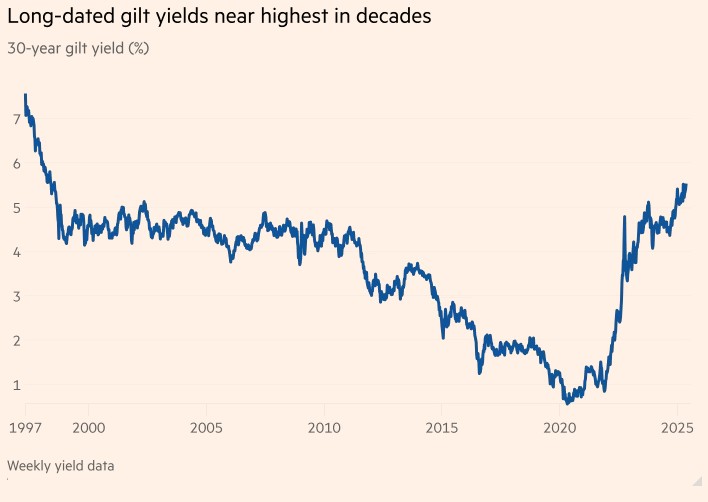The Yield Curve, and Long-Term Gilts
The Financial Times on 27th May carried an article entitled “UK turns to shorter-term borrowing as fiscal pressure mounts”, and sub headed “Head of Debt Management Office [DMO] says demand for long-term gilts is waning”. It notes that long term gilts yields are at their highest level “in decades” and that the DMO is planning to reduce issuance of long-term gilts. We thought it might be useful to look at the attraction of these long gilts for private investors, and to provide an explanation of the yield curve.
30-Year Gilt Yields at Multi-Decade Highs
The yield on 30-year UK gilts is currently trading well above 5% (5.45% as of 28th May), a level not sustained since the late 1990s.

This represents a significant re-rating of long-term risk-free rates, which has been driven by:
- Structural fiscal concerns, including elevated government borrowing and rising debt servicing costs, exacerbated by evidence of a Cabinet split on spending
- Quantitative tightening, with the BoE reducing its gilt holdings, having moved from being a buyer to a seller (with a corresponding negative effect on gilts prices and a rise in yields)
- The retreat of defined-benefit pension funds from the market.
Long-duration gilts now offer attractive nominal returns. For liability-driven investors such as pension funds or family offices managing intergenerational wealth, the income can be seen as both secure and attractive, relative to recent decades – at least if sterling is seen as an acceptable base currency. Private investors may also be attracted to the current yields to park cash for the long-term, in the knowledge that there is very good liquidity in these bonds should they need to sell before maturity.
The UK Gilt Yield Curve
What Is the Yield Curve?
The yield curve is a graphical representation of interest rates (or yields) on government bonds of different maturities at a single point in time. In the UK, it is typically drawn using gilts — government bonds ranging from short-term (e.g. one year) to long-term (e.g. 30 years). Here is the current UK gilts yield curve (the blue line), showing the change in shape since a year ago:

Common Shapes of the Yield Curve and What They Mean
Normal (Upward-Sloping) Curve:
A normal curve is when long-term bonds have higher yields than short-term ones. This is typical in a healthy, growing economy. Investors demand a higher return for tying up money for longer periods.
Flat Curve:
A flat curve happens when yields are similar across all maturities. This may be a signal that markets are unsure whether growth or recession is ahead.
Inverted Curve (Downward-Sloping):
An inverted yield curve happens when long-term yields are lower than short-term ones. This is fairly unusual and often seen as a recession warning. Investors expect rates to fall in the future due to slowing growth or falling inflation.
The current gilt curve is particularly steep out to a peak at 30 years. This implies the market is pricing in persistent inflation risk and uncertainty around the pace of rate cuts. Investors are demanding compensation for duration risk, fiscal uncertainty and supply overhang.
The Bank of England’s Quantitative Tightening that started on 1st November 2022 has not helped. The Bank actively reversed its previous Quantitative Easing operations by not only ceasing reinvestment of maturing gilts but also initiating active gilt sales. In addition, there has been reduced demand for duration among liability-driven investors (predominantly managers of defined contribution pension funds) post the “LDI crisis”, which followed the mini budget in 2022, and because defined contribution funds themselves have become a smaller part of the market.
For long-term investors this may represent an opportunity to lock in relatively attractive rates not seen since the late 1990s.
Breakeven Inflation and Real Yields
The 30-year gilt breakeven inflation rate, calculated as the difference between nominal and index-linked gilt yields of equivalent maturity, currently sits at approximately 3.5%. This implies:
- Investors locking in a 30-year nominal yield of c. 5.0% are implicitly assuming that CPI inflation will average below 3.5% over the next three decades, in order to outperform index-linked gilts.
- The corresponding real yield (on index-linked gilts) is +/- 1.5%, substantially above levels prevailing throughout the 2010s, when real yields were consistently negative. This change to some extent reflects investors’ adverse experience of index-linked gilts in the period of increasing nominal rates since 2019, when the inflation adjustment feature was outweighed by their behaviour as bonds.
If one believes that long-term UK inflation will revert to the Bank of England’s 2% target, then conventional gilts at these levels appear highly attractive in real terms. Conversely, if inflation proves more stubbornly embedded above 3%, inflation-linked gilts (or real assets) become the superior hedge.
Qualifying Corporate Bond (QCB) rule
Some of the long-duration gilts were issued when rates were much lower and, correspondingly, are now trading at substantial discounts to their eventual redemption price. For example, the 1.625% 2054 gilt is trading at 45.122. Under current QCB rules, the accretion over time to 100, over a third of the return, would be free of capital gains tax.
So – Should Private Investors Consider 30-Year Gilts Now?
Private investors with long time horizons may well want to consider 30-year gilts at current yields to form part of their portfolios. These bonds offer:
- Capital preservation and income visibility in a volatile macroeconomic backdrop.
- A potential hedge against recessionary risk.
- A historically attractive real yield pickup, assuming inflation moderates.
Risks include resurgent inflation, continued UK fiscal deterioration, and a structurally higher global rate regime. As such, investors might want to consider a blend of standard and inflation-linked gilts, as well as some corporate bonds and MTN issues to enhance the yield of the portfolio overall. At LGB, we continue to favour a buy-and-hold laddered fixed income portfolio, investing in fixed income instruments with staggered maturities to benefit from regular liquidity and a defined overall return.













